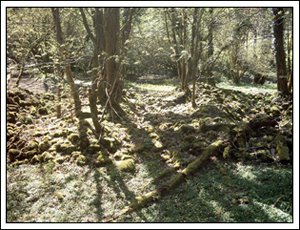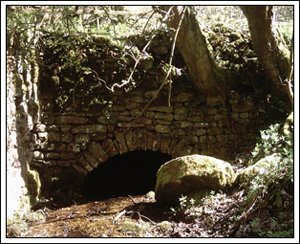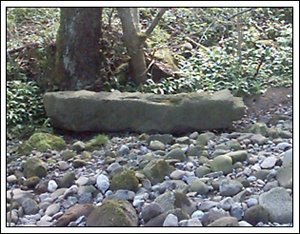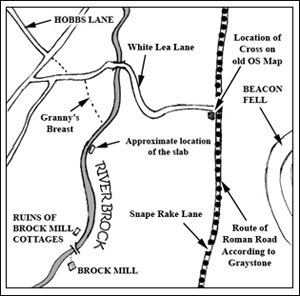Camouflaged beneath a net of ivy against the backdrop of the misty forest, Brock Mill suddenly looms at the occasional rambler from its tangled undergrowth with an undeniable romanticism. So much so in fact that, when we paid it a visit one crisp April morning recently, it looked to us like some lost Peruvian temple. All of which makes it doubly hard to believe that, only a few short years ago, this crumbling ruin was a busy café and rocking dance hall, and before that a thriving industrial centre for local craftsmen.

Okay…maybe it was never actually ‘thriving’, having spent most of its existence in receivership, but it’s still difficult to imagine what life must have been like for those workers (whose cottages are nowadays also reduced to nothing more than rubble sketch-marks on the forest floor) scraping a living in the secluded depths of Brock Bottoms.
Perhaps we ought to put some history in place here, and for that we’ll turn to the highly informative ‘Brock Bottoms: A History of the Mill and the Community’ by S. Parker. In the early 1790’s apparently: ‘…a Preston firm, Lorimer and Company, built a cotton spinning factory in Brock Bottoms.’ Twenty cottages, the ruins of which can be seen below (at least, they can if you study the photograph for long enough paying close attention to the cobbles beneath the briars), were also constructed for the workers.

In 1796 Lorimer’s shares in the mill went up for sale, a warning that all wasn’t well in the tiny community. By 1807 the mill itself was on the market, its owner at the time, John Eamer, having declared himself bankrupt. And so, over the following century, the mill’s fortunes rose and fell with alarming frequency, a savage fire in 1860 sounding the death knell on its actual cotton spinning.

All wasn’t lost, however, and it was rebuilt in 1861 by Richard and William Bond, who reopened the building to the manufacture of rollers for spinning firms. Thirty years later the mill received a further facelift, this time by P.J.B. Parker who converted the premises into a file-making firm.
In 1936, however, under the ownership of Crompton Crompton (whose parents, presumably, lacked a certain amount of imagination when it came to naming their children) Brock Mill was finally closed, the ground floor becoming (as we mentioned earlier) a café, whilst the top floor was handed over to late night revellers; the heady strains of the Calder Vale Band no doubt echoing around the steeply sided valley into the small hours.
It’s interesting to note, perhaps, that since the publication of S. Parker’s booklet in 1992 (working on the assumption that the photographs contained within it are contemporary) the remaining walls have lost their upper storey to steady decay.
All of which, we’re sure you’d agree, is fascinating but not particularly new. So, let’s head back up the Brock towards the car park and see if we can furnish the reader with something a bit more intriguing.

The photograph above was taken from the opposite bank of the River Brock, somewhere between the bridge on White Lea Lane and the rubble of Brock Mill cottages. We couldn’t say where exactly, because the river winds considerably in this vicinity and, somewhat thoughtlessly, we hadn’t packed a milometer before we set out.
The huge slab, from where we were standing, appeared to measure roughly eight feet in length. Not having our Wellingtons with us, we weren’t about to risk pneumonia by wallowing through the rapids for a closer look. What really caught our eye, however, was its unique shape. There was clearly a tenor joint carved into one end, and the entire obelisk bore a remarkable similarity to the keeill cross shaft that originally stood at Forton.

Naturally intrigued we decided to conduct a few further investigations at home and the first thing that caught our eye was the close proximity of our suspected cross shaft to the Ribchester to Lancaster Roman road, as recorded by Phillip Graystone.
Keeills, as anybody who’s been following our obsession with these ancient churches will already know, were often built within half a mile or so of Roman roads and Old Ways. The reason for this can be put down to the fact that when keeills began to spring up across our fifth century landscape the Romans had only recently abandoned Britain to its fate. Roman roads and Old Ways were the main and only routes between settlements at the time so a carefully placed advertisement for the culdee’s wares in the shape of a cross by the roadside seemed an obvious step.
And what do we have marked on the 1946 Ordnance Survey map at the junction of Snape Rake Lane and White Lea Lane? White Lea Cross, that’s what! Now, to the best of our knowledge, this ancient shaft is no longer standing and, under the circumstances, we couldn’t help wondering whether it had ended up at Brock Bottoms or not.
There is, of course, further evidence to support the idea of a keeill in the area. Here’s what John Dixon and Jaana Järvinen had to say about nearby Hobbs Lane in their book ‘Historic Walks Around Bleasdale’: “An interesting name that refers to the folk legend that a Hobgoblin resided in these parts. Names like this reflect a popular mythology, a belief in the supernatural world of dragons, elves, goblins, giants and dwarfs.”
As excellent a book as ‘Historic Walks Around Bleasdale’ is, we, of course (being Smart Alec’s) know better. We refer the reader to a previous newsletter instalment in the Keeill saga entitled ‘When the Hampson Dobby met the Brunsa Hobby’.
Hobbies, boggarts, dobbies, phynnodderees, fer-obbees, ben-obbees and hobgoblins, as we mentioned in that particular article, all belong to the same phenomenon, that being culdees. Hobbs Lane, therefore, would originally have been the route used by one such ‘Devotee of God’.
Interestingly, if extended towards our potential keeill cross shaft on the bank of the river, Hobbs Lane crosses the enigmatically named ‘Nanny’s Breast’ shown in the photograph below.

Was this, perhaps, the site of the original keeill? Another possibility lies at the other end of Hobbs Lane with Butt Hill, the word ‘butt’ sometimes referring to mediaeval archery ranges but at other times pagan burial mounds; exactly the sort of place where keeills tended to be constructed.
Whatever the case, further investigations concerning our possible keeill cross will have to wait for now. Before we left Brock Bottoms we helped ourselves to a few pieces of pottery found scattered amongst the ruins of the mill. We’re not entirely sure whether this was legal or not, but there didn’t appear to be any signs around telling us not to, so we did it anyway. These included treacle ware, popular from the seventeenth century onwards, a large fragment of which was discovered on Bourne Hill during our 2005 excavations. Several other interesting shards have yet to be identified but, no doubt, all of them are connected with the mill’s activities.

Okay…maybe it was never actually ‘thriving’, having spent most of its existence in receivership, but it’s still difficult to imagine what life must have been like for those workers (whose cottages are nowadays also reduced to nothing more than rubble sketch-marks on the forest floor) scraping a living in the secluded depths of Brock Bottoms.
Perhaps we ought to put some history in place here, and for that we’ll turn to the highly informative ‘Brock Bottoms: A History of the Mill and the Community’ by S. Parker. In the early 1790’s apparently: ‘…a Preston firm, Lorimer and Company, built a cotton spinning factory in Brock Bottoms.’ Twenty cottages, the ruins of which can be seen below (at least, they can if you study the photograph for long enough paying close attention to the cobbles beneath the briars), were also constructed for the workers.

In 1796 Lorimer’s shares in the mill went up for sale, a warning that all wasn’t well in the tiny community. By 1807 the mill itself was on the market, its owner at the time, John Eamer, having declared himself bankrupt. And so, over the following century, the mill’s fortunes rose and fell with alarming frequency, a savage fire in 1860 sounding the death knell on its actual cotton spinning.

All wasn’t lost, however, and it was rebuilt in 1861 by Richard and William Bond, who reopened the building to the manufacture of rollers for spinning firms. Thirty years later the mill received a further facelift, this time by P.J.B. Parker who converted the premises into a file-making firm.
In 1936, however, under the ownership of Crompton Crompton (whose parents, presumably, lacked a certain amount of imagination when it came to naming their children) Brock Mill was finally closed, the ground floor becoming (as we mentioned earlier) a café, whilst the top floor was handed over to late night revellers; the heady strains of the Calder Vale Band no doubt echoing around the steeply sided valley into the small hours.
It’s interesting to note, perhaps, that since the publication of S. Parker’s booklet in 1992 (working on the assumption that the photographs contained within it are contemporary) the remaining walls have lost their upper storey to steady decay.
All of which, we’re sure you’d agree, is fascinating but not particularly new. So, let’s head back up the Brock towards the car park and see if we can furnish the reader with something a bit more intriguing.

The photograph above was taken from the opposite bank of the River Brock, somewhere between the bridge on White Lea Lane and the rubble of Brock Mill cottages. We couldn’t say where exactly, because the river winds considerably in this vicinity and, somewhat thoughtlessly, we hadn’t packed a milometer before we set out.
The huge slab, from where we were standing, appeared to measure roughly eight feet in length. Not having our Wellingtons with us, we weren’t about to risk pneumonia by wallowing through the rapids for a closer look. What really caught our eye, however, was its unique shape. There was clearly a tenor joint carved into one end, and the entire obelisk bore a remarkable similarity to the keeill cross shaft that originally stood at Forton.

Naturally intrigued we decided to conduct a few further investigations at home and the first thing that caught our eye was the close proximity of our suspected cross shaft to the Ribchester to Lancaster Roman road, as recorded by Phillip Graystone.
Keeills, as anybody who’s been following our obsession with these ancient churches will already know, were often built within half a mile or so of Roman roads and Old Ways. The reason for this can be put down to the fact that when keeills began to spring up across our fifth century landscape the Romans had only recently abandoned Britain to its fate. Roman roads and Old Ways were the main and only routes between settlements at the time so a carefully placed advertisement for the culdee’s wares in the shape of a cross by the roadside seemed an obvious step.
And what do we have marked on the 1946 Ordnance Survey map at the junction of Snape Rake Lane and White Lea Lane? White Lea Cross, that’s what! Now, to the best of our knowledge, this ancient shaft is no longer standing and, under the circumstances, we couldn’t help wondering whether it had ended up at Brock Bottoms or not.
There is, of course, further evidence to support the idea of a keeill in the area. Here’s what John Dixon and Jaana Järvinen had to say about nearby Hobbs Lane in their book ‘Historic Walks Around Bleasdale’: “An interesting name that refers to the folk legend that a Hobgoblin resided in these parts. Names like this reflect a popular mythology, a belief in the supernatural world of dragons, elves, goblins, giants and dwarfs.”
As excellent a book as ‘Historic Walks Around Bleasdale’ is, we, of course (being Smart Alec’s) know better. We refer the reader to a previous newsletter instalment in the Keeill saga entitled ‘When the Hampson Dobby met the Brunsa Hobby’.
Hobbies, boggarts, dobbies, phynnodderees, fer-obbees, ben-obbees and hobgoblins, as we mentioned in that particular article, all belong to the same phenomenon, that being culdees. Hobbs Lane, therefore, would originally have been the route used by one such ‘Devotee of God’.
Interestingly, if extended towards our potential keeill cross shaft on the bank of the river, Hobbs Lane crosses the enigmatically named ‘Nanny’s Breast’ shown in the photograph below.

Was this, perhaps, the site of the original keeill? Another possibility lies at the other end of Hobbs Lane with Butt Hill, the word ‘butt’ sometimes referring to mediaeval archery ranges but at other times pagan burial mounds; exactly the sort of place where keeills tended to be constructed.
Whatever the case, further investigations concerning our possible keeill cross will have to wait for now. Before we left Brock Bottoms we helped ourselves to a few pieces of pottery found scattered amongst the ruins of the mill. We’re not entirely sure whether this was legal or not, but there didn’t appear to be any signs around telling us not to, so we did it anyway. These included treacle ware, popular from the seventeenth century onwards, a large fragment of which was discovered on Bourne Hill during our 2005 excavations. Several other interesting shards have yet to be identified but, no doubt, all of them are connected with the mill’s activities.



















5 comments:
Hello again.
The obelisk part is definitely interesting, especially to someone like myself who has a fondness for standing stones, and similar items.
You definitely need to cross the stream and make some measurements and more detailed photographs. Perhaps vandals moved the cross, so they could have a place to sit by the waterside, or perhaps it was dragged away for use as a gatepost, like so many of those Anglo-Saxon boundary markers that I hope you will be discussing soon.
Either way, I'm sure readers like myself would like to see some diagrams on the construction of keeill cross shafts, so we can understand why you came to this conclusion?
Thanks again for sharing your fascinating countryside with us. I did some digging in my own back yard, and found a coin from 1972. Yipee.
Cheers, JOHN :0)
John...I'll see what I can do regarding those keeill crosses over the next few weeks.
I look forward to it. Also, could you reprint here your article, 'When the Hampson Dobby met the Brunsa Hobby’ for those of us from distant parts? That sounds fascinating :0)
John...I'll do that as well (although you might have to remind me in a week or so's time).
The text names the Wood as Nanny's Breast, as does the O/S 6 Inches to 1Mile -sheet SD 54 SW. Taking the footpath to 'short-cut' which starts from between the car park and the old mill, coming out on to Brock Mill Lane, you climb up what the map calls 'Nanny's Rake'.
I don't know where "Granny's" comes in - it's erroneous.
Post a Comment